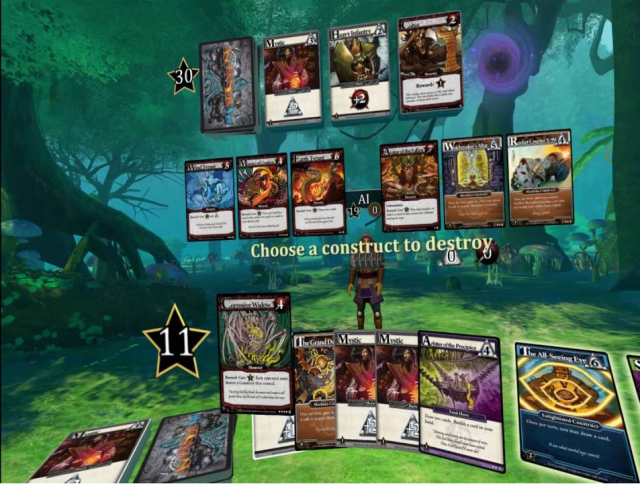Ascension is best known as a game that found major success in the early days of both app-based board gaming and of the deck-building card game genre. This combined novelty made Ascension’s app an easy buy, but can the same success be replicated by Ascension VR, over half a decade later?
It seems inevitable that every write-up of a VR multiplayer game will include the following caveat: the install base for VR platforms simply doesn’t support public matchmaking at this time. Sure, the option is there, but what made the Ascension app such a tempting play was quick matches that could easily fill any moment of prolonged downtime. However, getting into an Ascension VR match requires you to be at home, hooked into your VR rig. Only then does the nearly endless wait for another begin.
But the Ascension app and Ascension VR are separate creatures, so not all direct comparisons are fair. Public quickplay simply isn’t the use case for VR at this time. Where Ascension VR succeeds is in demonstrating much of what VR can offer tabletop gaming, to the point that the term “tabletop” even seems a bit silly here. What’s tabletop gaming without a table? Ascension VR does away with the table and takes the game vertical, suspending it in the air in front of you.
A wall of cards might invoke some visions of Minority Report, but there’s no hand-tracking use of the HTC Vive’s motion  controllers. Card selection and control is instead handled by centering your vision on what you want to interact with, and then clicking a button (picture the hand controllers hanging by your side). The experience leaves you feeling more like a telekinetic and less like a futuristic Tom Cruise.
controllers. Card selection and control is instead handled by centering your vision on what you want to interact with, and then clicking a button (picture the hand controllers hanging by your side). The experience leaves you feeling more like a telekinetic and less like a futuristic Tom Cruise.
Card interactions are mainly for playing or obtaining cards, but some of Ascension VR’s smart design allows you to bring up card information, thereby overcoming some of early VR’s flaws. For instance, fine details outside of a narrow center focus range tend to get quite blurry in VR, so Ascension VR counters this by assigning one button to a traditional “zoom in on this card” button, while a second button is additionally assigned to displaying just the body text of the card in a very large font. The game puts multiple tools in the player’s toolbox, allowing them to pull out whatever details they need in the most comfortable manner possible.
The smart design even extends to VR’s social capabilities, resulting in an interaction that feels very natural. Spatial chat is included (an audio effect to handle volume and directionality of voice chat, depending on player’s’ relative positions), but Ascension VR goes one step further by analyzing players’ speech to add character lip syncing and emotions. There’s also the simple visual of the other player managing their cards directly across from you. It just feels right.
The game isn’t all polish, though. Actual gameplay in Ascension VR might leave veteran players wanting, as only the base game is included at this time. That feeling extends to the game’s ability to support strategic play, as a move log is missing. This can make play against the AI especially challenging, as a new card may enter the center row, only to then be claimed before players even have the opportunity to read the new card’s text.
Much like it’s app predecessor, Ascension VR will likely be remembered as an early example of a proven formula. Hopefully, the game’s feature set and card variety will continue to expand over time, and more players begin populating its lobbies. The latter may be helped out by the game’s prudent decision to support full cross-play between HTC Vive, Oculus Rift, and the mobile Gear VR platform. Only time will tell how the game matures, but regardless, Ascension VR will still have at least one major accomplishment: selling players on a concept.
Comments
No comments yet! Be the first!